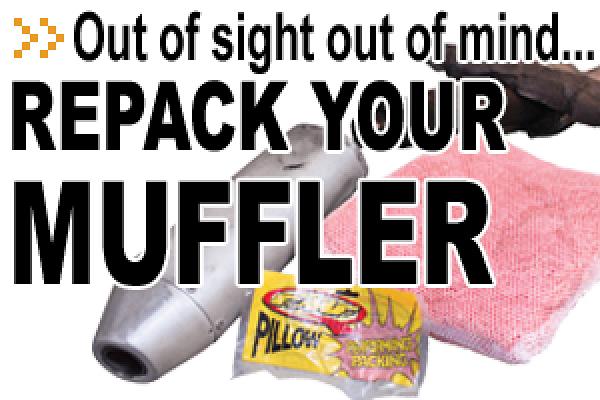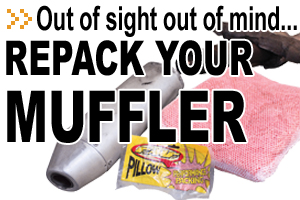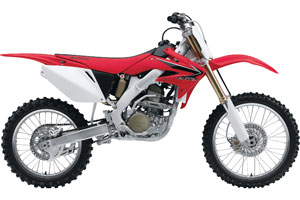How To Repack A Muffler

Out of sight out of mind...
The exhaust leaving your engine exits the pipe in waves that travel through the silencer. Packing muffler packing material like fibergalss around the pipe outlet helps the muffler control those waves as they leave your bike.
That stuff inside gets old, burns up and often exits along with those waves. On a two-stroke, the muffler's packing ages because of the unburned mix that leaves the cylinders. On a four-stroke, high heat is the main culprit that kills muffler packing. When it's gone, your bike gets louder, and its performance degrades.
It can happen quickly, too. We know mechanics who recommend new muffler packing after every 10 hours of riding. That could be once a month, or even more frequently.
Quick Tips: Got a screw loose?
Some aftermarket mufflers, like FMF for example, use screws rather than the rivets to secure the end cap. These screws make it easy to remove and reinstall the end cap when repacking your muffler. You can check out some of the FMF products we carry at Chapmoto.com.
How to Repack a Muffler
We know some of you don't believe you really need to replace the muffler packing, or at least not so frequently. But did you notice your bike getting louder? The people around you have noticed - and that can be bad for all motorcycle riders.
One more thing: Repacking your bike's muffler will add horsepower to your bike. Seriously. With a freshly packed silencer, your bike will again be able to run like when you bought it (assuming all other maintenance is up to date). So you'll regain the power you lost when your old packing material packed up and left!
REMOVE THE OLD PACKING
There is hardly an easier maintenance job. To prove it, we did most of the work atop the seat of this old Honda® CR-F. You simply remove the muffler from the bike (Photo 1); that means pulling off one side cover, then removing a couple bolts that hold the muffler in place. Save the clamp that connects the muffler to the main pipe, of course.
To access the packing, we had to drill out each rivet on this stock Honda muffler's outer case. Some bikes, and many aftermarket mufflers, use hex-head bolts to hold the muffler case in place. After drilling out a few rivets, we were wishing for those hex-head bolts, or maybe just a better drill bit.
The outer case won't simply fall away from the head of the muffler. We had to give the muffler's mounting bracket a few good taps to loosen the case. When it did come apart, we saw the real need for new packing. This Honda®'s muffler packing was almost completely gone (Photo 2).
A bit of scrap packing remained inside, and we cleaned that from around the silencer core, and also made sure to check inside the muffler's outer case for any packing that may have burned to the walls! Finally, we cleaned the inner core with a metal brush; ours was actually pretty clean, but old packing material will clog those holes and must be removed for best muffler performance.
Muffler Packing Material
When shopping for muffler packing material you'll come across a variety of options such as pillow packing and pressed packing. The names are pretty descriptive as the pillow type is fluffy and the pressed type is more dense. Chaparral Motorsports offers the Moose Racing Packing Pillow which is a high heat, durable packing material that can be cut to length to fit your muffler. You'll also see that there is two stroke and four stroke muffler packing. Chaparral Motorsports offers FMF Racing 4-stroke Muffler Packing as well as FMF Premier 2 Stoke Muffler Packing. offers both two stroke and four stroke muffler packing. Both of these are the pressed packing type and are made from fiberglass material and designed for high heat resistance and sound absorption.
Repacking
The FMF Performance Pillow Packing makes this job simple (Photo 3). All we had to do was wrap the one-piece pillow around the silencer core (Photo 4), making sure to seat it in the head of the muffler case. Then we used some masking tape (Photo 5) to hold it together so we could finish the job. That tape will burn away without harm.
You don't want to wrap the packing material too tightly; just get it to fit around the silencer core and inside the outer case. That case isn't going to just slip on; it's a close fit and we had to work the pillow packing into the case as we pushed the two together.
Before assembling the two pieces, we applied a silicon "liquid gasket" to the base (Photo 6). Then we worked the outer case back onto the muffler pipe, and it fit perfectly. Just make sure the silencer core inside lines up properly with the case's end cover.
We also had to straighten a few kinks in the case and pipe from our rivet-removal, but with that done the pieces came together well and we secured them with new rivets (Photo 7). We reconnected the muffler to the exhaust pipe, and mounted it on the bike - ready to ride (Photo 8).











